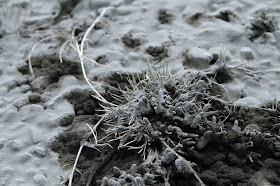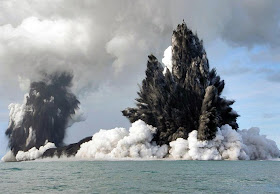LONDON (AP) -- Thick drifts of volcanic ash blanketed parts of rural Iceland on Friday as a vast, invisible plume of grit drifted over Europe, emptying the skies of planes and sending hundreds of thousands in search of hotel rooms, train tickets or rental cars.
"The skies are totally empty over northern Europe," said Brian Flynn, deputy head of Eurocontrol, adding "there will be some significant disruption of European air traffic tomorrow." The agency said about 16,000 of Europe's usual 28,000 daily flights were canceled Friday -- twice as many as were canceled a day earlier. U.S. airlines canceled 280 of the more than 330 trans-Atlantic flights of a normal day, and about 60 flights between Asia and Europe were canceled.
Southern Iceland's Eyjafjallajokull (ay-yah-FYAH'-plah-yer-kuh-duhl) glacier began erupting for the second time in a month on Wednesday, sending ash several miles into the air. Winds pushed the plume south and east across Britain, Ireland, Scandinavia and into the heart of Europe. The air traffic agency Eurocontrol said almost two-thirds of Europe's flights were canceled Friday, as air space remained largely closed in Britain and across large chunks of north and central Europe. (21 images)
"The skies are totally empty over northern Europe," said Brian Flynn, deputy head of Eurocontrol, adding "there will be some significant disruption of European air traffic tomorrow." The agency said about 16,000 of Europe's usual 28,000 daily flights were canceled Friday -- twice as many as were canceled a day earlier. U.S. airlines canceled 280 of the more than 330 trans-Atlantic flights of a normal day, and about 60 flights between Asia and Europe were canceled.
Southern Iceland's Eyjafjallajokull (ay-yah-FYAH'-plah-yer-kuh-duhl) glacier began erupting for the second time in a month on Wednesday, sending ash several miles into the air. Winds pushed the plume south and east across Britain, Ireland, Scandinavia and into the heart of Europe. The air traffic agency Eurocontrol said almost two-thirds of Europe's flights were canceled Friday, as air space remained largely closed in Britain and across large chunks of north and central Europe. (21 images)
Follow The Frame on Twitter at sacbee_theframe
The volcano in southern Iceland's Eyjafjallajokull glacier sends ash into the air just prior to sunset on Friday, April 16. Thick drifts of volcanic ash blanketed parts of rural Iceland on Friday as a vast, invisible plume of grit drifted over Europe, emptying the skies of planes. AP / Brynjar Gauti
Smoke billows from a volcano in Eyjafjallajokull on April 16. Iceland's second volcano eruption in less than a month has sent plumes of ash and smoke billowing more than 20,000 feet (6,000 metres) into the sky. The massive ash cloud is gradually sweeping across Europe and forcing the continent's biggest air travel shutdown since World War II. AFP / Getty Images / Halldor Klobeins
Footprints in volcanic ash fallen to ground Friday April 16, near Myrdalssandur, some 220km east of the capital Rejkavik, Iceland. AP / Brynjar Gauti
A woman wears a mask and goggles to protect herself from ash caused by volcanic activity Friday April 16, some 120km east of the capital Rejkavik, Iceland. Authorities told people in the area with respiratory problems to stay indoors, and advised everyone to wear masks and protective goggles outside. AP / Brynjar Gauti
A computer enhanced image provided by the German Aerospace Center, DLR, on Friday, April 16, shows a photo of the volcano under the Eyjafjallajokull glacier on Iceland taken by the TerraSAR-X satellite on Thursday evening, April 15. AP / TerraSAR-X
A landscape flattened by floodwaters caused by volcanic activity on the Markarfljot river bank Friday, April 16, some 120km east of the capital Reykjavik, Iceland. AP / Brynjar Gauti
Ice chunks carried downstream by floodwaters caused by volcanic activity lie on the Markarfljot river bank Friday April 16, some 120km east of the capital Rejkavik, Iceland. AP / Brynjar Gauti
Ground staff secure a plastic protective cover on the engines of an aircraft at Belfast City Airport in Northern Ireland, on April 16. AFP / Getty Images / Peter Muhly
Travelers wait at the closed international Airport in Duesseldorf, Germany, Friday, April 16. Most countries in northern Europe suspended their air traffic due to ash clouds from the volcanic eruption in Iceland. AP / Martin Meissner
Passengers gather in front of flight information screens at Roissy Charles de Gaulle Airport, as hundreds of commercial flights across northern Europe are canceled by a drifting plume of volcanic ash originating from Iceland, outside Paris, Friday, April 16. AP / Christophe Ena
Passengers use camp beds as they wait for the resumption of air travel on April 16, at the airport in at Frankfurt airport, the biggest in Germany. AFP / Getty Images / Torten Silz
In this photo released by the Icelandic Coastguard on Friday, April 16, officers in a coastguard plane monitor the activity of the volcano under the Eyjafjallajokull glacier in Iceland. AP / Icelandic Coastguard
The crater of the volcano under the Eyjafjallajokull glacier in Iceland, is shown in this photo released by the Icelandic Coastguard on Friday, April 16. AP / Icelandic Coastguard
This image provided by NOAA shows the volcanic plume, from Wednesday's eruption of a volcano beneath Iceland's Eyjafjallajokull glacier. Using sulfur dioxide concentration data from the NASA Aura/ OMI satellite sensor, it shows smoke, ash, and other components that can cause aircraft jet engines to fail. The OMI sensor can distinguish the differences between cloud, smoke, dust, ozone and other aerosols, and is important in Earth observations for aviation safety. AP / NOAA



































Hiç yorum yok:
Yorum Gönder